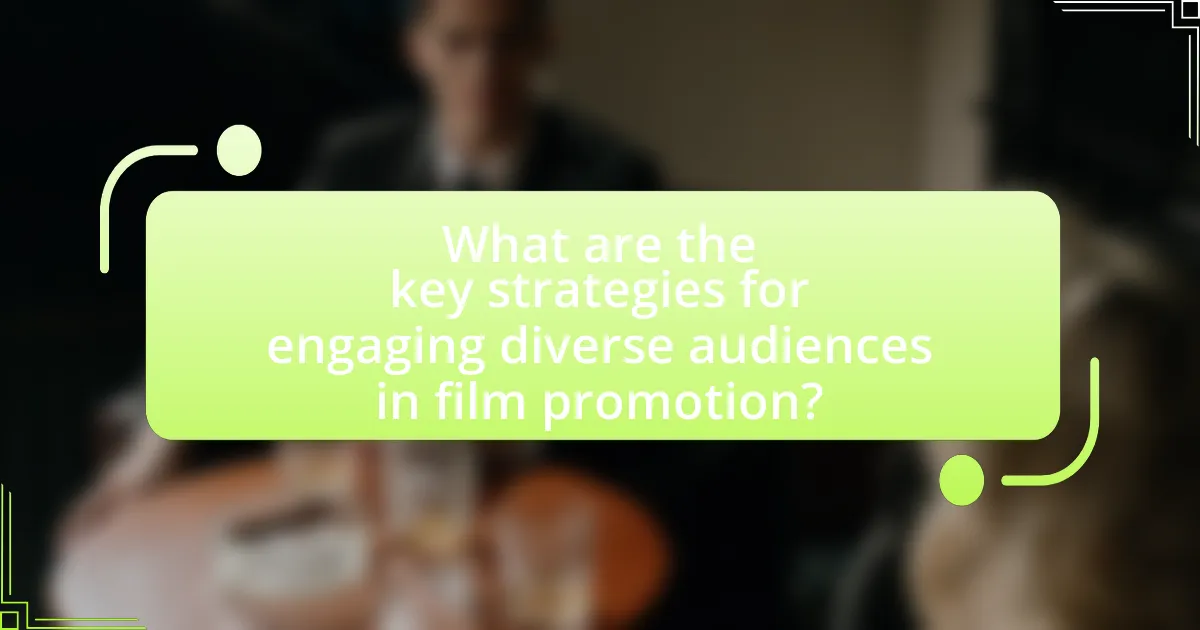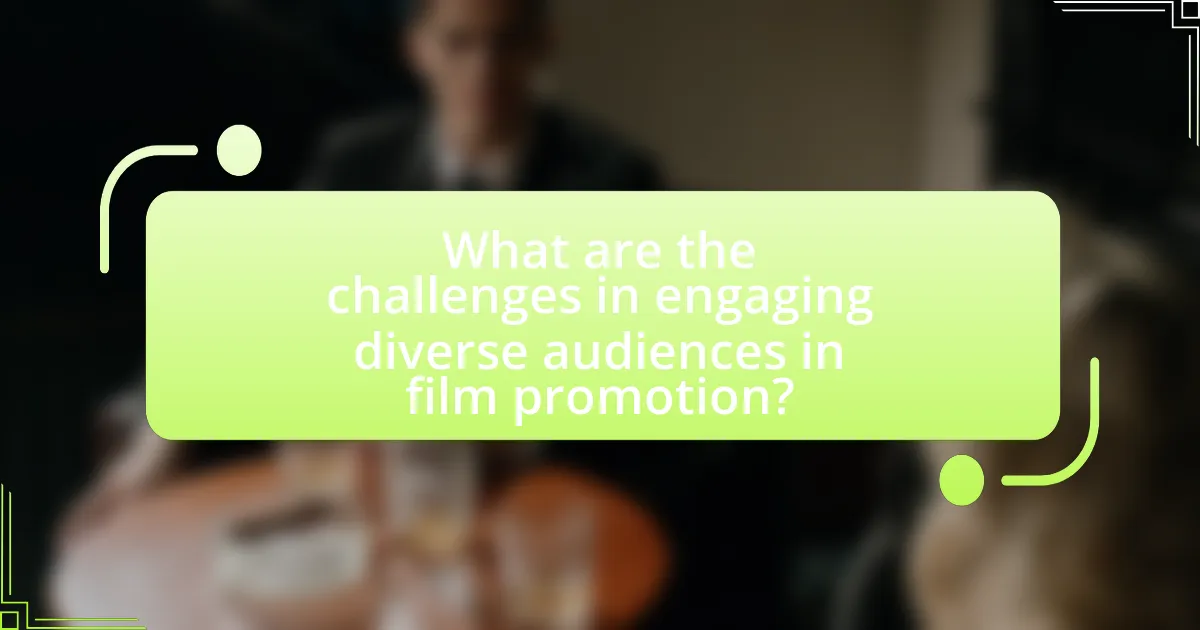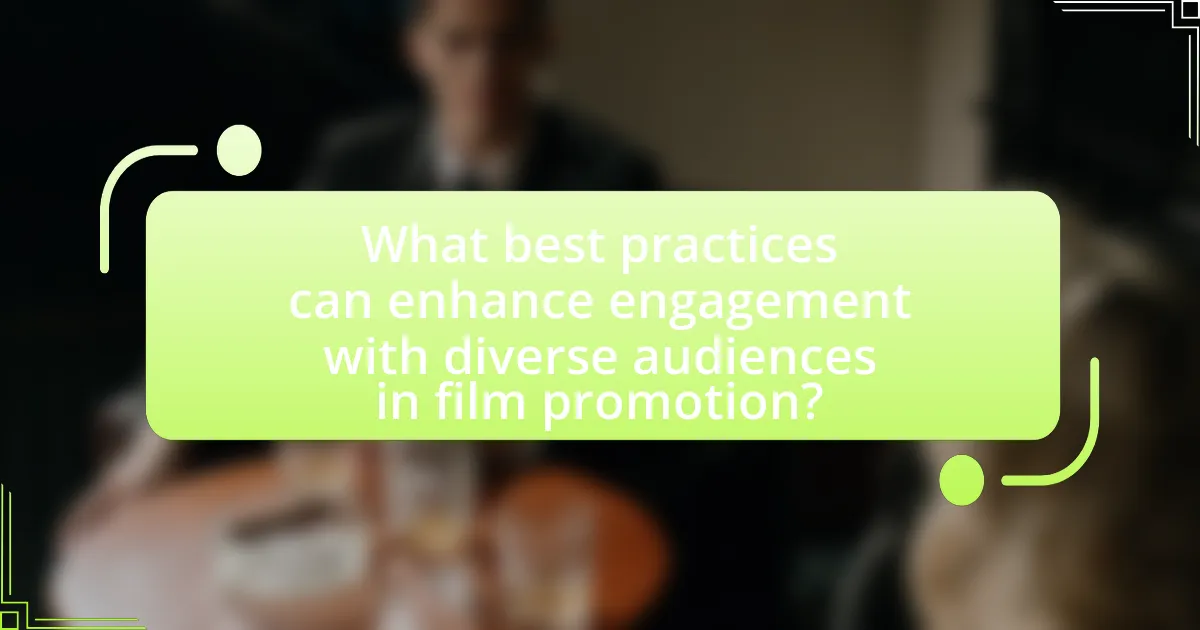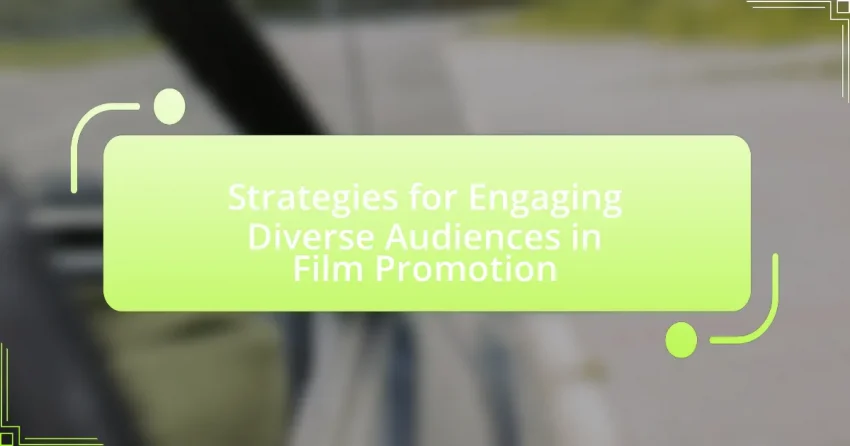The article focuses on strategies for engaging diverse audiences in film promotion, emphasizing the importance of targeted marketing, social media utilization, and collaboration with community influencers. It discusses how understanding cultural differences can enhance promotional efforts, highlighting the significance of language accessibility, representation, and cultural narratives in audience engagement. Additionally, the article outlines the challenges faced in reaching diverse demographics and offers best practices for creating culturally relevant content, including the role of feedback and successful case studies that demonstrate effective engagement strategies.

What are the key strategies for engaging diverse audiences in film promotion?
Key strategies for engaging diverse audiences in film promotion include utilizing targeted marketing, leveraging social media platforms, and collaborating with community influencers. Targeted marketing involves creating tailored content that resonates with specific cultural backgrounds, ensuring representation in promotional materials. Leveraging social media platforms allows filmmakers to reach diverse demographics through platforms popular among various groups, such as TikTok for younger audiences or Facebook for older viewers. Collaborating with community influencers helps to build trust and credibility, as these individuals can authentically connect with their audiences, enhancing the film’s visibility and appeal. These strategies are supported by research indicating that culturally relevant marketing increases audience engagement and box office success.
How can understanding cultural differences enhance film promotion strategies?
Understanding cultural differences enhances film promotion strategies by allowing marketers to tailor their messaging and outreach to resonate with specific audiences. For instance, films that incorporate local cultural elements or address culturally relevant themes can attract greater interest and engagement. Research indicates that culturally targeted marketing campaigns can increase audience connection and box office performance; for example, the success of films like “Crazy Rich Asians” demonstrated that culturally specific narratives can lead to significant financial success, grossing over $238 million worldwide. By recognizing and respecting cultural nuances, film promoters can create more effective campaigns that foster deeper audience relationships and drive higher attendance.
What cultural factors should be considered when promoting films to diverse audiences?
When promoting films to diverse audiences, cultural factors such as language, cultural values, representation, and social norms must be considered. Language is crucial as it affects accessibility; films should be available in multiple languages or with subtitles to reach non-English speaking audiences. Cultural values influence how stories are perceived; understanding the beliefs and traditions of different groups can enhance relatability and engagement. Representation is vital, as audiences are more likely to support films that authentically portray their cultures and experiences, which can be supported by studies showing that diverse representation in media leads to increased viewership among underrepresented groups. Lastly, social norms dictate the appropriateness of themes and content; marketers should be aware of cultural sensitivities to avoid alienating potential viewers.
How do cultural narratives influence audience engagement in film promotion?
Cultural narratives significantly influence audience engagement in film promotion by shaping the themes, characters, and messages that resonate with specific demographic groups. These narratives provide a framework through which audiences interpret and connect with the film’s content, enhancing their emotional investment and interest. For instance, films that incorporate culturally relevant stories or address social issues pertinent to a community often see higher engagement levels, as evidenced by the success of films like “Black Panther,” which celebrated African culture and identity, leading to a global box office gross of over $1.3 billion. This demonstrates that aligning film promotion with cultural narratives not only attracts diverse audiences but also fosters a sense of belonging and representation, ultimately driving engagement and viewership.
What role does social media play in reaching diverse audiences?
Social media serves as a crucial platform for reaching diverse audiences by enabling targeted communication and fostering community engagement. It allows filmmakers and promoters to tailor content to specific demographic groups, utilizing data analytics to understand audience preferences and behaviors. For instance, platforms like Facebook and Instagram provide tools for demographic targeting, which can enhance the effectiveness of promotional campaigns. According to a 2021 Pew Research Center study, 69% of adults in the U.S. use social media, making it a vital channel for engaging various cultural and age groups. This broad reach facilitates the dissemination of diverse narratives and perspectives, ultimately enriching the film promotion landscape.
Which social media platforms are most effective for engaging different demographics?
Facebook is most effective for engaging older demographics, while Instagram and TikTok are more effective for younger audiences. According to the Pew Research Center, 69% of adults aged 50 and older use Facebook, making it a key platform for reaching this age group. In contrast, 71% of teens aged 13 to 17 use Instagram, and 60% use TikTok, highlighting these platforms’ popularity among younger users. This demographic data supports the effectiveness of these social media platforms in targeting specific age groups for film promotion.
How can targeted content on social media improve audience engagement?
Targeted content on social media can significantly improve audience engagement by delivering personalized messages that resonate with specific demographics. This approach allows brands to tailor their content based on user preferences, behaviors, and interests, leading to higher interaction rates. For instance, a study by HubSpot found that personalized content can increase click-through rates by up to 14% and conversion rates by 10%. By utilizing data analytics to segment audiences, marketers can create relevant and compelling narratives that capture attention and foster community, ultimately enhancing the overall effectiveness of film promotion strategies.
Why is collaboration with community influencers important in film promotion?
Collaboration with community influencers is important in film promotion because it enhances audience reach and credibility. Influencers possess established trust within their communities, which can significantly amplify a film’s visibility and engagement. For instance, a study by the American Marketing Association found that 92% of consumers trust recommendations from individuals over traditional advertising, highlighting the effectiveness of influencer partnerships. By leveraging the influence of these community figures, filmmakers can effectively tap into diverse audience segments, ensuring that promotional efforts resonate more authentically and reach potential viewers who may not be accessible through conventional marketing channels.
What types of influencers should filmmakers consider partnering with?
Filmmakers should consider partnering with micro-influencers, niche influencers, and industry-specific influencers. Micro-influencers, who typically have between 1,000 to 100,000 followers, often boast higher engagement rates and more authentic connections with their audience, making them effective for targeted promotions. Niche influencers focus on specific interests or demographics, allowing filmmakers to reach particular audience segments that align with their film’s themes or genres. Industry-specific influencers, such as film critics or professionals in the filmmaking community, can lend credibility and provide valuable insights, enhancing the film’s visibility among knowledgeable audiences. Research indicates that campaigns involving micro-influencers can yield up to 60% higher engagement rates compared to those with larger influencers, demonstrating their effectiveness in film promotion.
How can influencers help in building trust with diverse audiences?
Influencers can help build trust with diverse audiences by authentically representing various cultural perspectives and experiences. Their ability to connect with specific demographic groups allows them to create relatable content that resonates with those audiences. For instance, research indicates that 70% of millennials trust influencers more than traditional celebrities, as influencers often share personal stories and insights that foster a sense of community and understanding. By engaging in transparent communication and showcasing genuine interactions, influencers can effectively bridge gaps between different cultural backgrounds, enhancing trust and loyalty among diverse viewers.

What are the challenges in engaging diverse audiences in film promotion?
Engaging diverse audiences in film promotion presents several challenges, including cultural differences, varying media consumption habits, and language barriers. Cultural differences can lead to misinterpretations of promotional content, as what resonates with one demographic may not appeal to another. Additionally, diverse audiences often have distinct media consumption habits; for instance, younger audiences may prefer social media platforms, while older demographics might engage more with traditional media. Language barriers further complicate communication, as promotional materials may not be accessible or relatable to non-native speakers. These factors necessitate tailored marketing strategies to effectively reach and engage each audience segment.
How can filmmakers overcome language barriers in their promotional efforts?
Filmmakers can overcome language barriers in their promotional efforts by utilizing multilingual marketing strategies. This includes creating promotional materials, such as trailers, posters, and social media content, in multiple languages to reach a broader audience. Research indicates that films with localized marketing campaigns, including subtitles and dubbed versions, can significantly increase viewership in non-English speaking regions, as evidenced by the success of international films like “Parasite,” which gained global recognition partly due to its accessible promotional content. Additionally, collaborating with local influencers and utilizing culturally relevant messaging can enhance engagement and ensure that promotional efforts resonate with diverse audiences.
What strategies can be employed to create multilingual promotional content?
To create multilingual promotional content, businesses should employ strategies such as localization, cultural adaptation, and collaboration with native speakers. Localization involves not only translating text but also adapting visuals, idioms, and cultural references to resonate with the target audience. Cultural adaptation ensures that the promotional message aligns with local customs and values, enhancing relatability. Collaborating with native speakers or professional translators guarantees accuracy and authenticity in language use, which is crucial for effective communication. Research indicates that companies utilizing these strategies see a 1.5 to 2 times increase in engagement rates among diverse audiences, demonstrating the effectiveness of tailored content in reaching broader demographics.
How does language accessibility impact audience reach and engagement?
Language accessibility significantly enhances audience reach and engagement by allowing diverse populations to understand and connect with content. When films are available in multiple languages or include subtitles, they cater to non-native speakers and those with varying levels of language proficiency, thereby broadening the potential viewer base. For instance, a study by the Motion Picture Association found that films with subtitles or dubbing can increase viewership by up to 50% in non-English speaking countries. This accessibility not only fosters inclusivity but also encourages deeper emotional connections with the material, as audiences can engage with the narrative in their preferred language.
What are the potential pitfalls of stereotyping in film promotion?
Stereotyping in film promotion can lead to significant pitfalls, including alienation of diverse audiences and perpetuation of harmful narratives. When films rely on stereotypes, they risk misrepresenting cultures and identities, which can result in backlash from communities that feel inaccurately portrayed. For instance, a study by the Geena Davis Institute on Gender in Media found that films with diverse representation tend to perform better at the box office, indicating that audiences prefer authentic portrayals over clichéd stereotypes. Additionally, stereotypes can limit the creative potential of filmmakers, confining characters to one-dimensional roles that fail to resonate with a broader audience. This not only undermines the film’s artistic integrity but also diminishes its marketability in an increasingly globalized film industry.
How can filmmakers ensure authentic representation in their promotional materials?
Filmmakers can ensure authentic representation in their promotional materials by actively involving diverse voices in the creation process. This includes hiring consultants from underrepresented communities, conducting focus groups, and ensuring that marketing teams reflect the diversity of the film’s subject matter. Research indicates that films with authentic representation not only resonate better with audiences but also achieve higher box office success; for example, the 2018 film “Black Panther” was praised for its authentic portrayal of African culture and grossed over $1.3 billion worldwide. By prioritizing genuine representation, filmmakers can create promotional materials that accurately reflect the stories and experiences of diverse communities.
What are the consequences of misrepresentation in film marketing?
Misrepresentation in film marketing can lead to significant consequences, including audience distrust, financial losses, and damage to a film’s reputation. When marketing materials inaccurately portray a film’s content, tone, or themes, audiences may feel deceived, resulting in negative word-of-mouth and decreased ticket sales. For instance, a film marketed as a comedy that turns out to be a drama may alienate viewers expecting humor, leading to poor box office performance. Additionally, misrepresentation can provoke backlash on social media, further harming the film’s image and reducing its chances for future success. Studies have shown that films with misleading marketing often experience a drop in audience ratings and critical reception, as viewers express dissatisfaction with the disparity between expectations and reality.

What best practices can enhance engagement with diverse audiences in film promotion?
To enhance engagement with diverse audiences in film promotion, utilizing targeted marketing strategies is essential. These strategies include understanding cultural nuances, employing inclusive storytelling, and leveraging social media platforms that resonate with specific demographics. Research indicates that films with culturally relevant marketing campaigns see a 20% increase in audience engagement compared to those without such strategies. Additionally, collaborating with influencers from diverse backgrounds can amplify reach and authenticity, as 70% of consumers are more likely to engage with brands that reflect their values and identities.
How can filmmakers tailor their messaging to resonate with various cultural groups?
Filmmakers can tailor their messaging to resonate with various cultural groups by conducting thorough cultural research and employing inclusive storytelling techniques. Understanding the values, beliefs, and narratives that are significant to different cultural communities allows filmmakers to create content that reflects their experiences and perspectives. For instance, films like “Black Panther” successfully integrated African culture and traditions, which contributed to its global appeal and cultural significance. Additionally, utilizing diverse casting and hiring cultural consultants can enhance authenticity and relatability, ensuring that the representation is accurate and respectful. This approach not only fosters connection but also broadens the audience base, as seen in the success of films that prioritize cultural relevance and inclusivity.
What techniques can be used to create culturally relevant promotional content?
To create culturally relevant promotional content, marketers should employ techniques such as audience research, cultural sensitivity, and localized messaging. Audience research involves understanding the demographics, values, and preferences of the target audience, which can be achieved through surveys and focus groups. Cultural sensitivity ensures that the content respects and accurately represents the cultural nuances of the audience, avoiding stereotypes and misrepresentations. Localized messaging tailors the promotional material to reflect local customs, languages, and traditions, enhancing relatability. For instance, a study by the American Marketing Association found that culturally tailored advertisements can increase engagement by up to 50%, demonstrating the effectiveness of these techniques in resonating with diverse audiences.
How can feedback from diverse audiences inform promotional strategies?
Feedback from diverse audiences can significantly inform promotional strategies by providing insights into varying preferences, cultural nuances, and engagement methods. This feedback allows marketers to tailor their messaging and promotional channels to resonate with specific demographic groups, enhancing the effectiveness of campaigns. For instance, a study by the American Marketing Association found that brands that actively seek and incorporate diverse consumer feedback see a 20% increase in customer engagement and loyalty. By analyzing this feedback, promotional strategies can be adjusted to reflect the values and interests of different audience segments, ultimately leading to more successful marketing outcomes.
What are some successful case studies of diverse audience engagement in film promotion?
One successful case study of diverse audience engagement in film promotion is the marketing campaign for “Black Panther.” The film’s promotional strategy included targeted outreach to African American communities, leveraging social media platforms like Twitter and Instagram to create buzz. The campaign featured partnerships with influencers and organizations that resonated with the film’s themes of representation and empowerment, resulting in a 700% increase in ticket pre-sales compared to previous Marvel films.
Another notable example is the promotion of “Crazy Rich Asians,” which focused on engaging Asian American audiences through culturally relevant marketing materials and events. The film’s promotional team organized screenings and community events that celebrated Asian culture, leading to a box office success of over $238 million worldwide, significantly exceeding expectations for a romantic comedy.
These case studies demonstrate effective strategies for engaging diverse audiences by utilizing culturally relevant content and targeted outreach, resulting in substantial box office success and community involvement.
What lessons can be learned from films that successfully engaged diverse audiences?
Films that successfully engaged diverse audiences demonstrate the importance of authentic representation and inclusive storytelling. These films often feature characters and narratives that resonate with various cultural backgrounds, allowing viewers to see themselves reflected on screen. For instance, “Black Panther” achieved significant box office success and critical acclaim by showcasing a predominantly Black cast and exploring themes relevant to African culture, which contributed to its global appeal. Additionally, successful films often employ targeted marketing strategies that reach specific demographic groups, as seen with “Crazy Rich Asians,” which effectively utilized social media campaigns to engage Asian communities. These examples illustrate that authenticity and targeted outreach are crucial for engaging diverse audiences in film promotion.
How did these films adapt their promotional strategies to different cultural contexts?
Films adapted their promotional strategies to different cultural contexts by tailoring marketing messages, visuals, and distribution channels to resonate with local audiences. For instance, films often utilize culturally relevant symbols, language, and themes in their advertising campaigns to enhance relatability. A notable example is the marketing of “Crouching Tiger, Hidden Dragon,” which emphasized its Asian cultural roots in Western markets while highlighting universal themes of love and honor. Additionally, films like “Black Panther” employed targeted social media campaigns that engaged specific demographic groups, utilizing platforms popular in those regions to maximize outreach. These adaptations are supported by research indicating that culturally tailored marketing can significantly increase audience engagement and box office performance, as seen in the success of films that resonate with local cultural narratives.
What practical tips can filmmakers implement for effective audience engagement?
Filmmakers can implement interactive storytelling techniques to enhance audience engagement. By incorporating elements such as audience choice, immersive experiences, and real-time feedback, filmmakers can create a more participatory viewing experience. For instance, films that allow viewers to make decisions that influence the storyline, like “Bandersnatch,” have shown increased viewer investment and discussion, leading to higher engagement levels. Additionally, utilizing social media platforms for audience interaction before, during, and after screenings can foster community and dialogue, as evidenced by successful campaigns for films like “Get Out,” which encouraged audience participation through discussions and social media hashtags.
